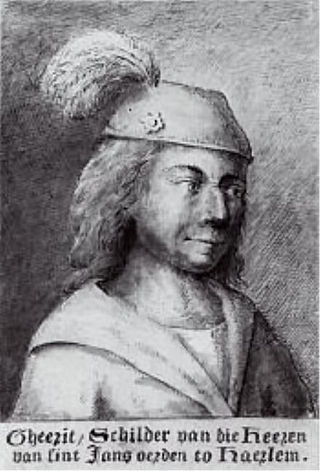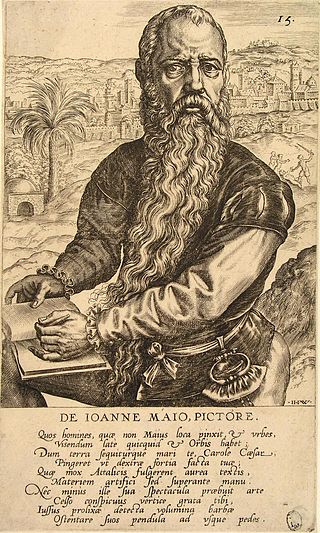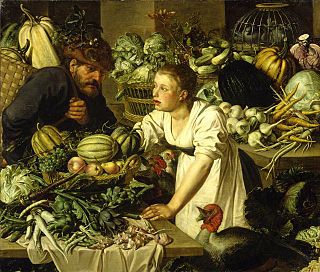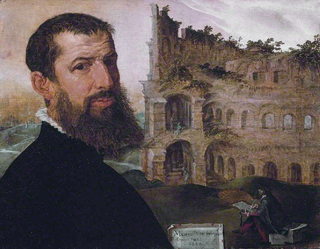
Maarten van Heemskerck, also known as Marten Jacobsz Heemskerk van Veen, was a Dutch portrait and religious painter, who spent most of his career in Haarlem. He was a pupil of Jan van Scorel, and adopted his teacher's Italian-influenced style. He spent the years 1532–36 in Italy. He produced many designs for engravers, and is especially known for his depictions of the Wonders of the World.

Karel van Mander (I) or Carel van Mander I (May 1548 – 2 September 1606) was a Flemish painter, playwright, poet, art historian and art theoretician, who established himself in the Dutch Republic in the latter part of his life. He is mainly remembered as a biographer of Early Netherlandish painters and Northern Renaissance artists in his Schilder-boeck. As an artist and art theoretician he played a significant role in the spread and development of Northern Mannerism in the Dutch Republic.

Geertgen tot Sint Jans, also known as Geertgen van Haarlem, Gerrit van Haarlem, Gerrit Gerritsz, Gheertgen, Geerrit, Gheerrit, or any other diminutive form of Gerald, was an Early Netherlandish painter from the northern Low Countries in the Holy Roman Empire. No contemporary documentation of his life has been traced, and the earliest published account of his life and work is from 1604, in Karel van Mander's Schilder-boeck.

Jan Cornelisz Vermeyen, or Jan Mayo, or Barbalonga was a Dutch Northern Renaissance painter.

Jan Mostaert was a Dutch Renaissance painter who is known mainly for his religious subjects and portraits. One of his most famous creations was the Landscape with an Episode from the Conquest of America.

Hendrik Cornelisz Vroom was a Dutch Golden Age painter credited with being the founder of Dutch marine art or seascape painting. Beginning with the "birds-eye" viewpoint of earlier Netherlandish marine art, his later works show a view from lower down, and more realistic depiction of the seas themselves. He is not to be confused with his son and pupil Cornelis Vroom.

Albert van Ouwater was one of the earliest artists of Early Netherlandish painting working in the Northern Netherlands, as opposed to Flanders in the South of the region.

Floris van Dyck, also called Floris van Dijck or Floris Claesz. van Dyck was a Dutch Golden Age still life painter.

Cornelis Corneliszoon van Haarlem was a Dutch Golden Age painter and draughtsman, one of the leading Northern Mannerist artists in the Netherlands, and an important forerunner of Frans Hals as a portraitist.

Jacob Cornelisz van Oostsanen was a Northern Netherlandish designer of woodcuts and painter. He was one of the first important artists working in Amsterdam, at a time when it was a flourishing and beautiful provincial town.

Pieter Fransz de Grebber (c.1600–1652/3) was a Dutch Golden Age painter.

The Haarlem Guild of Saint Luke was first a Christian, and later a city Guild for various trades falling under the patron saints Luke the Evangelist and Saint Eligius.

Cornelis Engelsz. (1575–1650) was a Dutch Golden Age painter and the father of Johannes Cornelisz Verspronck.

Pieter Cornelisz van Rijck, was a Dutch Golden Age painter.

Jan Nagel was a Dutch Renaissance painter.
Roger de Piles's L'Abrégé de la vie des peintres...avec un traité du peintre parfait was a major art biography of painters. It was written by the French spy Roger de Piles. In 1692, during the War of the League of Augsburg, he was arrested in the Hague carrying a false passport and imprisoned for the next five years, where he wrote his L'Abrégé in 7 parts; 1) Sketch of the perfect painter, 2) Greek painters; 3) Painters from Rome & Florence; 4) Painters from Venice; 5) Painters from Lombardy; 6) Painters from Germany and the Low Countries; 7) Painters from France and ending with his famous "Balance of painters". The book was finally published in 1699 following his appointment as Conseiller Honoraire to the Académie de peinture et de sculpture in Paris.

Self-portrait with the Colosseum is a 1553 painting by the Dutch Golden Age artist Maarten van Heemskerck in the Fitzwilliam Museum.

The St. Elisabeth Gasthuis (EG) is a former hospital complex of buildings founded in 1581 in Haarlem on the Gasthuisvest. The last location of the hospital on the Boerhaavelaan retains its hospital function and is part of the Spaarne Gasthuis (SG) today, formerly known as Kennemer Gasthuis (KG). The hospital complex on the Gasthuisvest was built for the "Minnebroers" monastery and was reclaimed after the Protestant reformation in 1581 and given by the city council to the hospital. As a hospital during four centuries, the complex underwent many major renovations. The main facade dates from 1871.

Haerlempjes refer to a specific genre of landscape painting that includes a view of Haarlem. It is used most often to refer to Jacob van Ruisdael's panoramic views of the city, but the term is derived from mentions in Haarlem archives as a type of painting included in household inventories. The diminutive suffix "pje" would denote a small, cabinet-sized painting, but even the largest landscapes may be referred to as Haerlempjes today.

Crucifixion is a 1543 polyptych by the Dutch Mannerist painter Maarten van Heemskerck in Linköping Cathedral consisting of a taller triptych above a shorter triptych, resulting in six panels in the front and four in the back.
























